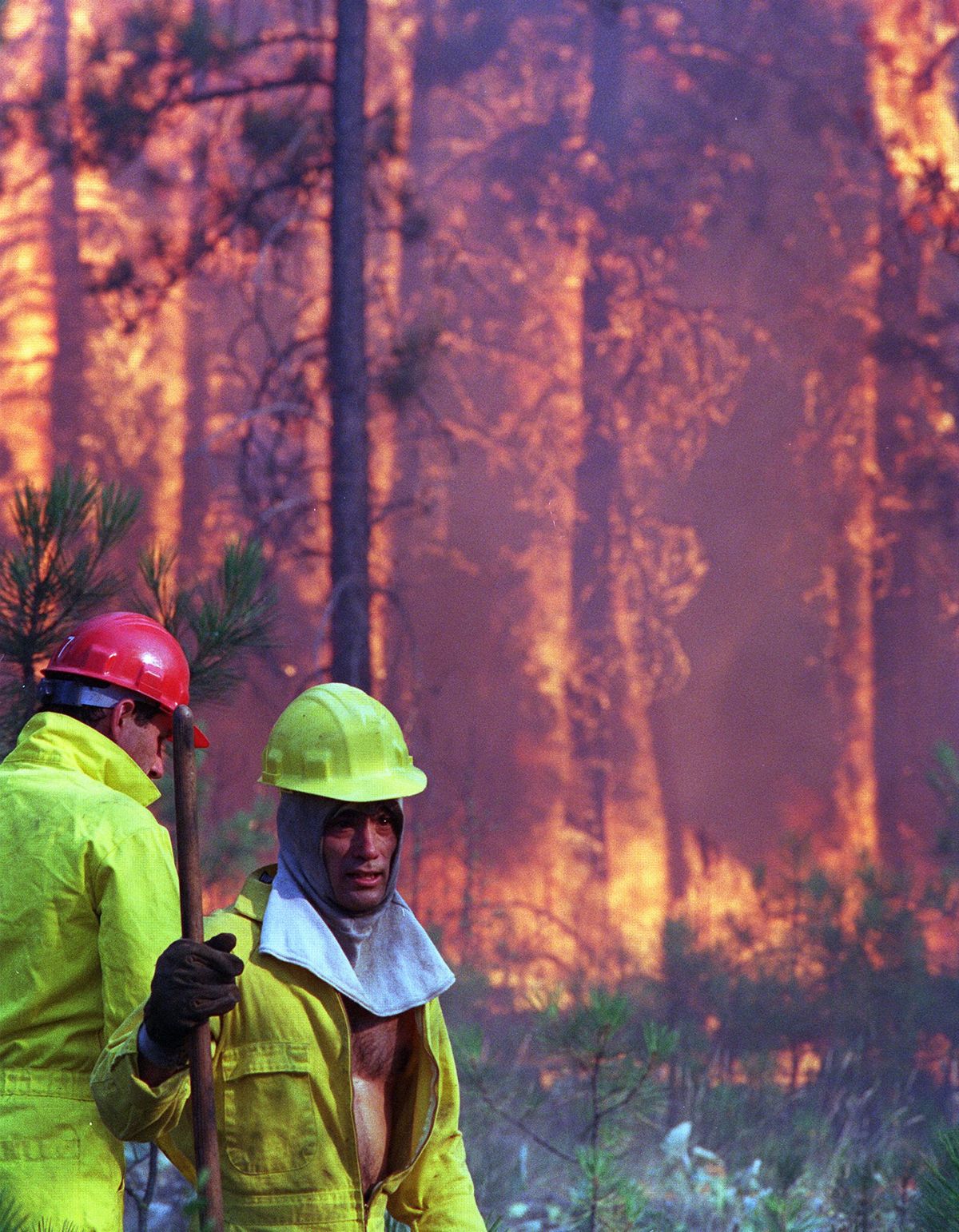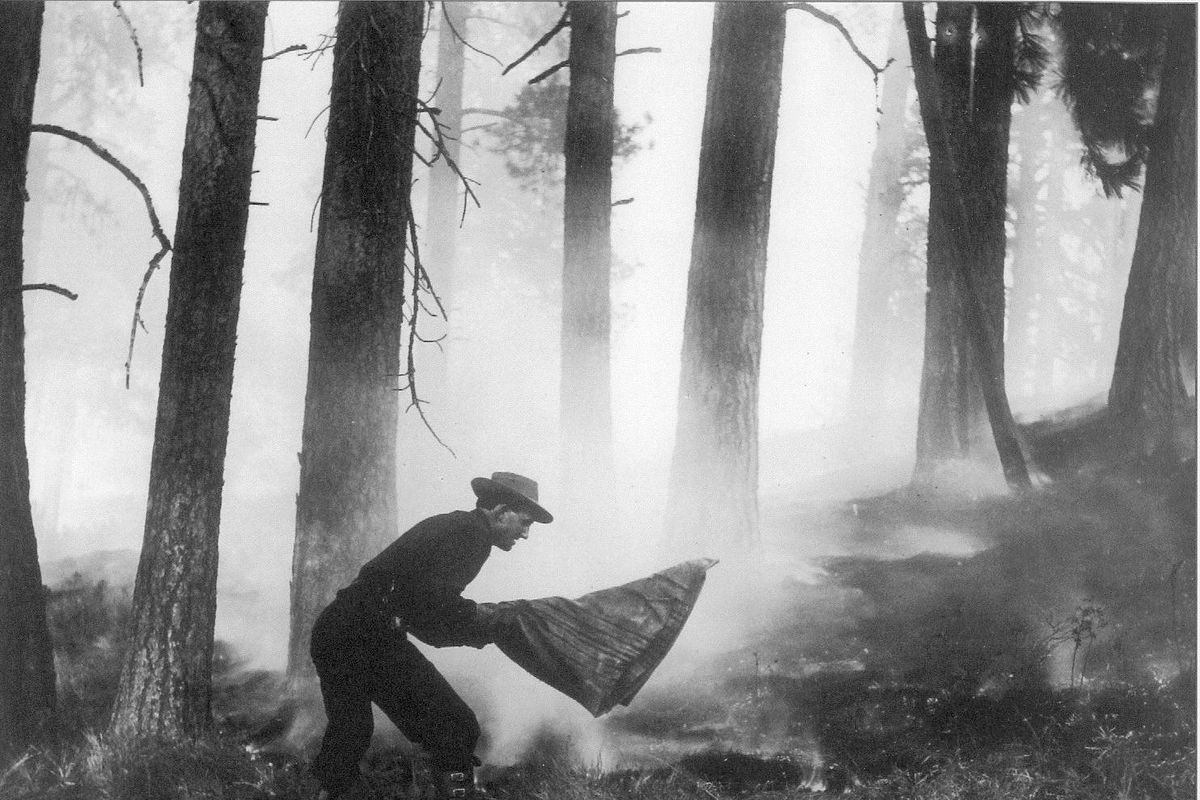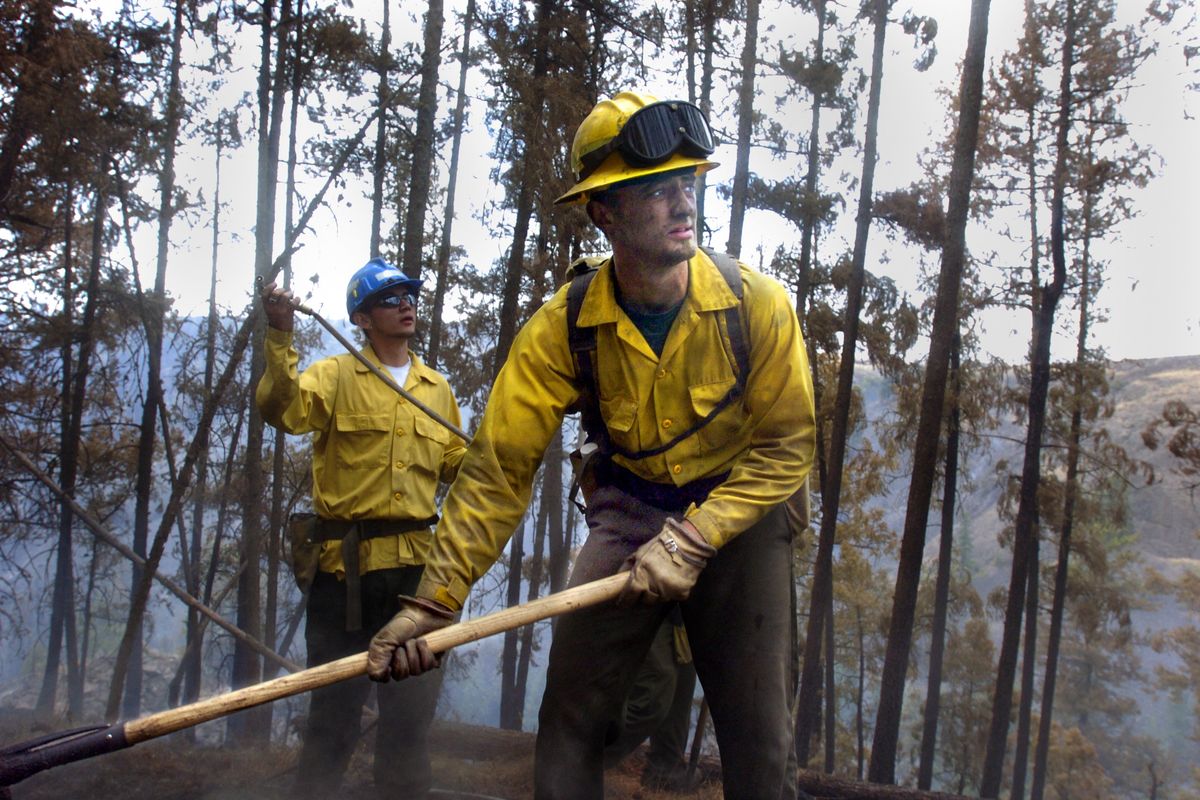Examining the legacy of the 1910 fires
While potential for another blowup exists, agencies have developed tools, techniques
The state of the art for fighting fires in 1910 was a blanket and a shovel. (Christopher Anderson / Courtesy of U.S. Forest Service)
One hundred years after the nation’s largest wildfires blazed across the Northern Rockies, blackening hillsides as far as the eye could see, the question lingers:
Could the Big Burn happen again?
Absolutely, says Mark Finney, a research forester at the Rocky Mountain Research Laboratory in Missoula.
The death toll of 85 would probably be lower. Modern firefighting emphasizes safety, weather forecasts are more sophisticated and better communication alerts rural residents when wildfires are headed their way.
But the events that triggered the 1910 Fire were largely natural phenomena. It’s possible that 3 million acres could burn again, with the majority of the land torched within 48 hours, Finney said.
“We have droughts today. … We have cold fronts and winds. … We have ignition factors. … All of the factors are still there.”
Other researchers have studied the 1910 Fire as a history-shaping event. Photos of ruined landscapes and ashy streams rallied public support for the U.S. Forest Service, which was a relatively unpopular federal agency at the time of the fires. Established just five years earlier, it was under attack from Western congressmen, who didn’t support government ownership of choice timber lands.
The Big Burn also became the Forest Service’s defining narrative. Tales of firefighters’ sacrifices and widespread destruction turned the agency into one of the world’s largest firefighting organizations, with 10,500 firefighters, a $1.6 billion annual fire suppression budget and a successful track record for putting out fires.
To Finney, however, the Big Burn remains a weather event. A drought, an active fire season and a cold front aligned to create one of North America’s most destructive fire storms.
“People tend to think of it as almost a supernatural event,” said Finney, who studies fire behavior. “It wasn’t. It was the convergence of three, rather typical weather patterns.”
The first was drought. After spring rains failed in 1910, the wildfire season got an early start. A few fires were reported in April.
“It was dry, but it wasn’t the driest year on record by any stretch of the imagination,” said Finney, noting that 2000, 2003 and 2007 shaped up as even drier years in the Northern Rockies.
The Big Burn’s second ingredient was active fires. Forest fires were reported throughout the summer, with a late July thunderstorm igniting hundreds of small blazes.
Here again, Finney said, the number of active fires wasn’t extreme. In 2003 and 2007, similar numbers of fires were burning across the Northern Rockies. But those years didn’t have the third and critical ingredient – wind.
On Aug. 20, 1910, an area of low pressure drifted south from Canada, creating counter-clockwise winds. Old-timers called them “Palousers,” because the winds appeared to blow from the southwest.
Hand-written records from the National Weather Service listed wind speeds near 20 mph in Spokane, Coeur d’Alene and Kalispell. Brisk, but not record-breakers, Finney said.
But the winds whipped up the active fires, “already cooking” in the forest, he said. Encountering tinder-dry terrain, the blazes spread quickly. As the fires grew in intensity, they created their own winds. Those were the gale-force blasts that uprooted trees and carried firebrands across canyons.
With those conditions, “you can make the fire run many, many miles in a single day,” Finney said.
But there are a couple of notable differences between now and 1910, according to the Forest Service. A century ago, most of the fire starts were human-caused. The railroad’s steam locomotives were notorious for igniting forest fires. Loggers also left campfires unattended and prospectors set deliberate fires to expose mineral outcroppings.
An estimated 75 percent of the fires in 1910 were caused by people, compared to 25 percent from lightning strikes. Today, far fewer wildfires are human caused. But an active lightning storm could still create the “saturated ignitions” that existed in 1910, Finney said.
The Forest Service also does a better job of detecting and putting out wildfires when they’re small, said Jason Kirchner, a spokesman for the Idaho Panhandle National Forests.
Some of the fires that blew up on Aug. 20 and 21, 1910, had been smoldering in the mountains since May, Kirchner said. They either went undetected, or strapped rangers didn’t have enough fire crews to fight them.
Today, “we put out 98 percent of wildfires, and we’re able to suppress most of them almost immediately,” Kirchner said.
For decades after the Big Burn, the Forest Service tried to stamp out all wildfires.
Putting out fires became a “moral imperative” of the agency, said Stephen Pyne, an Arizona State University history professor and author of “The Year of the Fires.” Forest Service rangers measured their success by how effective they were at extinguishing fires. It was a mission that played well with the public.
“Smoke in the woods was something that everyone could understand,” Pyne said during a recent talk in Coeur d’Alene.
But in the Northern Rockies, all-out fire suppression is at odds with natural cycles. The forests create woody debris faster than it can decay. Some plant species require periodic fires for regeneration. Wildlife, including deer and elk, use the openings left by fires for habitat.
“…In conquering an enemy, we have destroyed a friend whose presence in the ecosystem is as essential as the wind and rain,” William Moore, a retired Forest Service fire management chief, wrote in 1978.
By then, the agency’s stance on all-out fire suppression was softening. The Forest Service had begun setting small fires, called “prescribed burns,” to mimic natural fires. The agency also abolished the “10 a.m. rule,” which said that all forest fires should be out the morning after they were reported.
Most wildfires are still fought aggressively, said Jennifer Jones, a spokeswoman for the National Interagency Fire Center in Boise. Examples include human-caused fires, and fires that threaten lives or property.
But when a lightning storm recently sparked three fires on the St. Joe Ranger District, each less than one-third of an acre in size, Forest Service officials opted to let the fires burn, while monitoring them closely.
At the Coeur d’Alene Airport, an interagency dispatch center tracks wildfire activity in Idaho from the Canadian border to Lewiston. The center is a cooperative effort between the Forest Service, Bureau of Land Management, Idaho Department of Lands and the Coeur d’Alene Tribe. The agencies share the $450,000 cost of operating the center, which is staffed from May into October.
Three air tankers – each capable of carrying 800 gallons of fire retardant – are on standby. The center can also dispatch a Bell 212 helicopter that drops water from a bucket.
After thunderstorms, a satellite-based lightning detection program shows where the strikes occurred. The center contracts with local pilots to fly the area and report any fires.
“We keep track of every single firefighter, every single piece of firefighting equipment and every fire in the top half of the state,” said Gary Weber, the center’s assistant manager. “This is the hub of activity.”
The dispatch center has been quieter than usual this year, though, because of the heavy rains in May and June.
The center is an example of how firefighting has become safer and more sophisticated since 1910, said Kirchner, the Idaho Panhandle National Forests spokesman.
“Back then, you had your pack train and you went over the ridge. You were on your own,” he said. “You found the fire and you fought it where it seemed safest.”
The dispatch center is one of 14 in a region covering North Idaho, Montana, Yellowstone National Park, North Dakota and part of South Dakota.
If North Idaho’s firefighting needs outstrip local resources, dispatchers can order fire crews and equipment from a regional dispatch center in Missoula. If regional supplies and crews are scarce, requests are sent to a coordination center at the National Interagency Fire Center in Boise.
“They can look as far away as Florida for fire crews and equipment,” said Rose Davis, a Forest Service spokeswoman.
It’s a far cry from 1910, when the Coeur d’Alene National Forest’s firefighting budget was $30,000. Rangers had to beg for additional money to pay firefighters and order supplies.
But the best preparedness doesn’t alter geography. That’s was on Shoshone County Commissioner Vince Rinaldi’s mind this weekend, as the community of Wallace marked the anniversary of the 1910 Fire.
On Aug. 20 and 21, wildfires swept over the mountains into town. Damage to homes and businesses was estimated at $1 million. Two people died.
A century later, hills above the mountain town are green again, with dense stands of timber replacing the scorched hillsides visible in historic photographs. The re-growth is too thick for Rinaldi’s comfort.
“We’ve got a huge amount of forest that is very thick,” he said. “The fire potential is tremendous for us,”
Rinaldi and Shoshone County’s Board of Commissioners started a collaborative group last year to promote forest thinning projects. The effort targets 215,000 acres of federal, state and private forestland that surrounds populated areas of the Silver Valley. The goal is to reduce fuel-loads near communities.
Shoshone County hasn’t changed much in the past 100 years, Rinaldi noted. It’s still rural, still forested and still a firetrap.
Stringers of timber extend down narrow mountain canyons to the valley floor. It’s not hard to imagine fire roaring into Wallace as it did on the night of Aug. 20, 1910, when one-third of the town burned.
“It’s pretty much the same scenario,” Rinaldi said. “If 1910 taught us anything, it’s that fire can get here pretty quick.”
Sources include: “Year of the Fires,” by Stephen J. Pyne; “The Big Burn,” by Stan Cohen ; “The Big Burn,” by Timothy Egan






